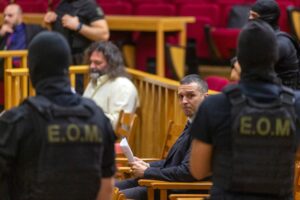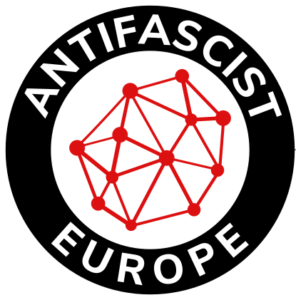Original text by Damian Lawlor, Offaly and Dieter Reinisch, published in German by junge Welt on 24 April 2022.
Translation by Joshua Rahtz
Historical reasons, apart from a brief episode in the 1930s, a fascist movement has never been able to establish itself in Ireland. Currently the National Party is seeking influence—but with limited success.
While right-wing and far-right formations such as Le Pen’s Front or Rassemblement National in France, Vlaams Belang in Belgium, and Vox in Spain have steadily increased in influence, Ireland has been mostly immune to the scourge. But this immunity to extreme-right movements appears to have waned recently.
Through the 20th century, the extreme right was virtually nonexistent in Ireland. Although Austrian archaeologist and Nazi Adolf Mahr founded a NSDAP faction there after assuming directorship of the Irish National Museum in Dublin in the 1930s, and while some nationalist Catholics had gone to Spain to fight alongside Franco, there was never a mass fascist base on the island; at no time was an extreme-right party represented in the Irish Parliament.
There are two main reasons for this. The two essential programmatic points of European fascism—nationalism and immigration—failed as instruments of propaganda in Ireland. In the former British colony, Irish nationalism could hardly be dominated by right-wing views. For decades it was anti-colonial, revolutionary, and left-wing. It drew on the ideas of the French Revolution—the Irish flag is inspired by the French tricolor and is meant to symbolize the coexistence of Catholics (green) and Protestants (orange). After the independence of the 26 southern counties in 1921-22, the new bourgeois state attempted a reinterpretation of patriotism, but Irish nationalism spans all parties on the political spectrum, most notably the republican and left-wing nationalist group Sinn Féin.
Nor is immigration a vote-winning cause for the far right in Ireland. Historically, Ireland has been shaped by migration. British colonial policy expelled a great many Irish Catholics, in that they were compelled for economic reasons to immigrate to North America in the 19th century; or it deported them to Australia as criminals because of their political activism. In the countries where immigrants settled, newly arrived Irish were often the victims of xenophobic attacks. It was not uncommon to find signs in restaurants in England and the US that read, “No Admission for Jews, Irish, or Dogs.” Irish were seen as a source of cheap labor in the countries to which they had immigrated. Yet immigration provided the only means of regular income for many Irish of the poor, rural regions in the West—not only during the famine years of the 1840s, but up through the beginning of the economic boom of the 1990s. In a country with such a history of immigration, the xenophobic politics of far-right groups never found fertile ground.
Right-wing dominance
The fact that Ireland’s extreme right has so far failed to achieve success at the ballot box does not mean, however, that the Republic is dominated by progressive parties. Until the 1980s, almost all parties represented in the Dublin Parliament were to the right of the political center. The two major parties, Fine Gael and Fianna Fáil, outdid themselves in claiming to be more right-wing than the other. Both maintained close contacts with the urban, pro-British middle classes and the wealthy rural classes, and have also been linked to the Catholic Church, which is influential nationally.
The situation was similar with the other parties on the political spectrum, such as the Irish Labour Party. Founded by the Irish Marxist James Connolly, it was an active force in the establishment of soviets (Irish Soviets) during the years of the Irish Revolution after the end of the First World War. In the decades that followed, however, it transformed itself into a conservative force which was consistently rated as right of center in polls of voters. On this spectrum, there was simply no room for parties further to the right: most of their positions were already covered by the parliamentary parties.
It was not until the 1980s that the Irish party spectrum began to move steadily to the left. Initially, this was due to the rise of the left-wing ex-republicans of the Workers’ Party. Later, the Greens were successful in elections, Trotskyist parties formed a stable parliamentary group lasting years, the moderate left-wing Social Democrats split from the Labour Party, and Sinn Féin’s election victories brought about a further leftward shift. As a result, the political spectrum in Ireland approached that of other Western European countries over the last decade. However, these developments also meant that extreme right-wing groups gained more ground.
The National Party, founded in 2016, has a membership which is gradually growing, and it initiates campaigns and organizes public events regularly. It now has several hundred members and several thousand supporters, making it a mounting challenge for leftists and anti-fascists. Apart from an obscure right-wing skinhead band called Celtic Dawn and visits from international representatives such as the old Front National warhorse Jean-Marie Le Pen and the late FPÖ frontman Jörg Haider, there had been no far-right scene in Ireland for nearly 70 years.
The last such movement to command a mass following was the “Blueshirts” of the 1930s, founded by former IRA commander Eoin O’ Duffy on the model of Benito Mussolini’s “Blackshirts.” After it, no fascist movement was able to gather any significant following. Thousands belonged to the “Blueshirts” and tens of thousands could be mobilized for their marches. They emerged from the fragmentation of the republican movement. Subsequent members of the “Blueshirts” fought almost without exception on the side of the counter-revolution during the Civil War of 1922-23. Yet the decisive action of the Fianna Fáil government against the “Blueshirts” and the intransigent street fighters of the Irish republican milieu around the IRA ensured that the fascist movement in Ireland was quickly defeated.
The rise of Eoin O’Duffy
Eoin O’Duffy was born in 1890, the son of a farmer from County Monaghan. Although he was not involved in the 1916 Rising, he joined the separatist movement in 1917 and quickly rose through its ranks. By 1921 he was deputy chief of staff of the IRA and also served on the leadership of the Irish Republican Brotherhood, a secret society that sought to gain as much influence as possible by deliberately infiltrating mass organizations.
O’Duffy supported the signing of the Anglo-Irish Treaty, which led to the partition of Ireland in 1921, and was appointed commander-in-chief of the Free State South Western Command—that is, the counter-revolutionary forces—during the Civil War. The Civil War was particularly brutal. Counter-revolutionaries sentenced 81 republicans to death and carried out countless extrajudicial killings. Among the most infamous events was the Ballyseedy Massacre, in which abused prisoners were strapped to a landmine which was then detonated.
O’Duffy continued to play an important role in the administration of the Irish Free State after the Civil War and was appointed commissioner of the Irish police, the Garda Síochána. He demonstrated a keen understanding of the challenges facing this new police force in a divided society. The Gardaí initially remained unarmed to ensure that they were not viewed as belligerents in the war.
O’Duffy also acted as a promoter of sport. He brought the Garda Síochána together with the Gaelic Athletic Association (GAA) and the National Athletic and Cycling Association (NACA). The aim was to heal the wounds inflicted by the war and give the police an able cohort of potential recruits.
Since O’Duffy had been a leader of the counter-revolutionary army in the Civil War and subsequently chief of police in the government led by Cumann na nGaedheal (Alliance of Gaels) from 1922 to 1932, it could not have been surprising that he was relieved of all posts when Éamon de Valera and his Fianna Fáil party took over the government. Fianna Fáil had been founded in 1927 by republican opponents of the partition of Ireland, while Cumann na nGaedheal, founded in 1922, was the party of supporters of the Anglo-Irish Treaty. In 1933, O’Duffy unsuccessfully plotted a coup to prevent Fianna Fáil from taking office.
The tension erupted in street fighting between supporters of Cumann na nGaedheal and the republicans. Leading IRA figure Frank Ryan put it this way: “[a]s long as we have fists and boots, there will be no freedom of speech for traitors.” But in response to the militant opposition against Cumann na nGaedheal undertaken by Fianna Fáil, the IRA, and members of the socialist Republican Congress, the Army Comrades Association (ACA) was formed.
The ACA’s official purpose was to look after the welfare of former members of the Free State Army, but in fact its real aim was the protection of public gatherings of Cumann na nGaedheal against republican protests. The ACA was close to Cumann na nGaedheal from the start, and assembly delegates Thomas F. O’Higgins, Ernest Blythe, Patrick McGilligan, and Desmond FitzGerald were leading members in both organizations.
The “comrades” of the ACA wore a blue-shirted uniform, hence their nickname, and gave the fascist salute with their right arms extended. Eoin O’Duffy emerged as their leader. The “Blueshirts” not only imitated the fascist movements in continental Europe, but also pursued the goal of establishing a fascist state on the island. In July 1933 the movement changed its name to the National Guard (NG). Not only did it seek to impose a stricter law-and-order regime, but more than this, O’Duffy and the NG fulminated against communism and called for the establishment of a corporative state.
With 30,000 “Blueshirts,” O’Duffy planned to march in Dublin in August 1933 in tribute to the memory of Arthur Griffith, Michael Collins, and Kevin O’Higgins. But the IRA and other radical activists mobilized to prevent them. The IRA drew up plans to move into houses and hide weapons in garbage dumps along the route in order to ambush the fascists; Mussolini’s “March on Rome” was not to be imitated in Dublin. In the end, however, the government preempted the republicans and banned the march as well as the fascist National Guard.
The “Blueshirts” thereafter renamed themselves the Young Ireland Association, and formed an alliance with Cumann na nGaedheal and the National Centre Party. They in turn jointly formed the liberal-conservative Fine Gael party, and O’Duffy was appointed party leader. But by September 1934 Fine Gael had had enough and expelled him. Over the following years, O’Duffy took part in the “Fascist International” conference at Montreux on Lake Geneva whose participants included Vidkun Quisling from Norway and Ernesto Cabellero, representative of the Spanish Falange movement. He later went to Spain and commanded an Irish brigade in the Civil War alongside Francisco Franco’s nationalists, monarchists, and fascists. In Ireland, however, the fascist movement disappeared as quickly as it arose. Fine Gael is now a right-wing conservative party in government.
The National Party attempts to get off the ground
As with the “Blueshirts” movement of the 1930s, the formation of the National Party in the 21st century is largely the initiative of one man: Justin Barrett, one of the figureheads of the far right for many years. He has in fact influenced Irish politics in various ways for three decades.
Barrett first rose to prominence as an activist in Youth Defence, a radical Catholic group that fought against the legalization of divorce in the late 1980s before resurfacing in the 1990s to campaign against abortion rights. As the movement’s spokesman, he organized protests in front of family planning clinics and distributed blood-stained flyers and posters showing aborted fetuses. It was in this manner that he brought the small movement into the headlines repeatedly.
Barrett later drew attention to himself as a representative of a campaign against the EU Treaty of Nice during the two referenda in 2001 and 2002. His name returned to headlines when it was revealed that he had spoken at meetings of the fascist Forza Nuova and NPD parties in Italy and Germany.
For left-wing and anti-racist activists, the disclosure of these connections to the right-wing scene in Europe did not come as a surprise. In his self-published 1998 book, The National Way Forward, Barrett had outlined how Ireland could become a “Catholic republic” in which immigration would be discouraged as much as possible and abortion would be banned generally.
Following the anti-EU campaigns, Barrett stood as an independent candidate in the 2004 European Parliament elections. His campaign focused on agitation against immigration. Catholic demands such as the fight against contraception, divorce, and abortion took a back seat. His new enemies were “bogus asylum seekers” and “mass immigration.” The call was to “give priority to Irish people in all job postings.”
Barrett founded the National Party in 2016. He and his friends from the Youth Defence of the 1990s formed its core, with James Reynolds as his deputy. The latter had come to the public’s attention in the mid-1990s when he praised Mussolini and Franco in the Irish media. The National Party’s founding was in any case tumultuous: the Merrion Hotel in Dublin canceled the inaugural event at short notice following a campaign by anti-racist and anti-fascist activists.
Most of today’s National Party agitators started out during the 2018 abortion referendum, in the efforts against liberalization of the legislation. The organization gained momentum during the Covid lockdowns when it incorporated traditionally left-wing concerns such as housing and cost-of-living issues into its agitation, and organized demonstrations against the Covid measures. It was thus able to mobilize a few thousand people in Dublin by the late summer of 2021. Rejection of immigration on the one hand, and a basis in Catholic social teaching remain central to the campaigns. The National Party has about 200 members, making it the strongest grouping on the developing far-right scene in Ireland.
Yet at the very moment when the National Party anticipated that it might organize further protests against Covid measures, it was confronted by a well-organized anti-fascist campaign. Its rise was thus halted. A protest outside Parliament, Leinster House, was broken up by a few hundred anti-fascist activists. National Party activists had to be escorted to safety by police.
Barrett then ran in a Dublin Bay South by-election last July. The new Liberal Labour leader, Ivana Bacik, won a resounding victory against the governing Conservatives. The National Party received just 183 votes, or 0.68 percent. While this sorry result was due mainly to voters’ rejection of the party’s aims, anti-fascists had also been active throughout the election campaign. They distributed leaflets publicizing the party’s fascist background, destroyed election posters, and attacked campaign events. As early as the February 2020 general election, none of the other right-wing candidates could summon more than one percent of the vote in any constituency, despite the fact that Ireland’s extreme right-wing groups are funded in part by hundreds of thousands of dollars from alt-right circles in the United States.
Loyalists and English Nazis
In Northern Ireland, the situation is different. There, too, the National Party tried to recruit supporters, but it was successfully prevented from doing so by Irish republicans. When an anti-lockdown protest was organized in Derry, local republican activists from the Irish Republican Socialist Party (IRSP) contacted the organizers and warned that there would be “consequences if the National Party turned up.” The party did establish bases in the neighboring county of Donegal, where Niall McConnell stood for the far-right Irish Patriots in the 2020 election. However, despite campaign spending of nearly €20,000, he received just 580 votes, for a share of 0.75 percent.
In Belfast, local republicans from the groups “Lasair Dhearg” and “Saoradh” blocked an attempt by the Irish Freedom Party to set up an information booth. The booth and its racist literature were destroyed, and members of the Irish Freedom Party were attacked. They fled within minutes out of fear for their safety.
As a result, far-right groups from the Republic of Ireland have not been able to establish themselves in Northern Ireland. Rather, the pro-British loyalist paramilitaries of the Ulster Volunteer Force (UVF) and the Ulster Defence Association (UDA) historically have maintained close ties with racists and neo-Nazis in England and Scotland. Parts of these paramilitary groups have been associated with the National Front, the British National Party, and “Combat 18” since the 1970s. During the Northern Ireland conflict from 1968 to 1998, the British far right was the only consistent international supporter of the loyalist paramilitaries.
For example, some fascists such as Frank Portinari and Terry Blackham helped the loyalists smuggle weapons and rob banks. Many of these joint operations failed, however, because so many fascist as well as loyalist organizations were populated by informants for the intelligence services.
Nevertheless, fascism was a significant influence on loyalist ideology. At a National Front march in Belfast in 1983, the main speakers were Johnny Adair and Sam McCrory. Both were members of the Nazi skinhead band Offensive Weapon at the time, and they later became leading UDA members. They were eventually imprisoned for murdering Catholics.
In the 1990s and early 2000s, many British fascists visited Northern Ireland as guests of the UDA and UVF. These visits were reported in the National Front Newsletter and Blood and Honour magazine. The ideological influence on loyalists is still evident today. In recent years, attacks on immigrants in loyalist areas have increased, and loyalists have marched in Ku Klux Klan garb outside mosques in Newtownards, east of Belfast.
In early summer particularly—when the marching season of the anti-Catholic Orange Order begins—Nazi stickers, racist graffiti, and Ku Klux Klan flags proliferate in the streetscape of south and east Belfast and other loyalist areas. Current rallies against the “Brexit” deal are also repeatedly attended by well-known neo-Nazis from the English Defence League, Britain First and other groups. However, republican, socialist and anti-fascist forces in both parts of Ireland are also well organized and vigilant, and continue to arrest the rise of Irish neo-Nazis. In this way, they guarantee that Ireland’s far right will remain a fringe force nine decades after the IRA crushed O’Duffy’s “Blueshirts.”
Damian Lawlor is an Offaly activist and author of Na Fianna Éireann and the Irish Revolution.
Dieter Reinisch is a historian at the National University of Ireland in Galway. He last wrote in this space on August 9, 2021 about the internment of the “Hooded Men” in Northern Ireland.







